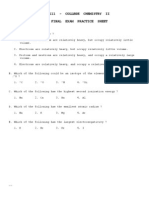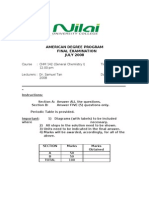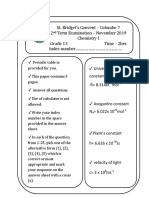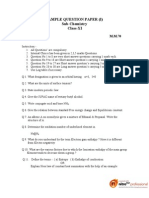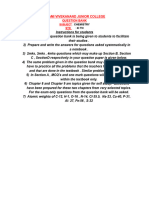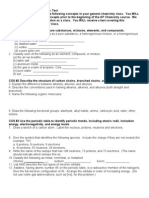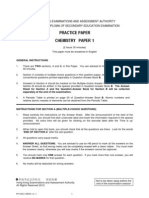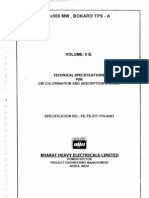0 ratings0% found this document useful (0 votes)
98 viewsCHE140 Written Test 1 S1 2014
CHE140 Written Test 1 S1 2014
Uploaded by
XuxuLanchauThis document is a chemistry exam consisting of 4 short answer questions testing students' knowledge of chemical equations, stoichiometry, empirical formulas, and thermite reactions. It provides instructions for calculators, working clearly with units, and allows 30 minutes to complete the test containing a total of 21 marks. An information sheet is included with additional reference materials such as solubility rules and common polyatomic ions.
Copyright:
© All Rights Reserved
Available Formats
Download as PDF, TXT or read online from Scribd
CHE140 Written Test 1 S1 2014
CHE140 Written Test 1 S1 2014
Uploaded by
XuxuLanchau0 ratings0% found this document useful (0 votes)
98 views8 pagesThis document is a chemistry exam consisting of 4 short answer questions testing students' knowledge of chemical equations, stoichiometry, empirical formulas, and thermite reactions. It provides instructions for calculators, working clearly with units, and allows 30 minutes to complete the test containing a total of 21 marks. An information sheet is included with additional reference materials such as solubility rules and common polyatomic ions.
Original Description:
cz
Copyright
© © All Rights Reserved
Available Formats
PDF, TXT or read online from Scribd
Share this document
Did you find this document useful?
Is this content inappropriate?
This document is a chemistry exam consisting of 4 short answer questions testing students' knowledge of chemical equations, stoichiometry, empirical formulas, and thermite reactions. It provides instructions for calculators, working clearly with units, and allows 30 minutes to complete the test containing a total of 21 marks. An information sheet is included with additional reference materials such as solubility rules and common polyatomic ions.
Copyright:
© All Rights Reserved
Available Formats
Download as PDF, TXT or read online from Scribd
Download as pdf or txt
0 ratings0% found this document useful (0 votes)
98 views8 pagesCHE140 Written Test 1 S1 2014
CHE140 Written Test 1 S1 2014
Uploaded by
XuxuLanchauThis document is a chemistry exam consisting of 4 short answer questions testing students' knowledge of chemical equations, stoichiometry, empirical formulas, and thermite reactions. It provides instructions for calculators, working clearly with units, and allows 30 minutes to complete the test containing a total of 21 marks. An information sheet is included with additional reference materials such as solubility rules and common polyatomic ions.
Copyright:
© All Rights Reserved
Available Formats
Download as PDF, TXT or read online from Scribd
Download as pdf or txt
You are on page 1of 8
CHE140 Fundamentals of Chemistry
Semester 1 2014 Written Test 1
Page 1 of 8
Surname
Given Name
Student number
Signature
CHE140 FUNDAMENTALS OF CHEMISTRY
WRITTEN TEST 1
Semester 1 2014
Total marks: 21 Reading time: 5 minutes Test time: 30 minutes
Instructions
Calculator
Scientific calculator only
(non QWERTY, memory cleared).
Provided by the student.
Information Sheet
The final page of the paper is an
information sheet, which may be
detached.
4 Short Answer Questions
Marks for each question
indicated
21 marks total
Answer the questions in the
spaces provided on the paper.
To obtain full marks students
must:
Show clear working
Give final answers to the
correct number of
significant figures
Show correct units
Examiners Use Only
Q 1 Q 2 Q 3 Q 4
CHE140 Fundamentals of Chemistry
Semester 1 2014 Written Test 1
Page 2 of 8
Answer the questions in the spaces provided
Question 1 (8 marks)
a) The equations for two chemical reactions shown below are not balanced. Balance
the equations by writing the appropriate coefficients in front of the formulas in the
equations.
KClO
3
(s) KCl(s) + O
2
(g)
(1 mark)
V
2
O
5
(s) + Ca(l) V(l) + CaO(s)
(1 mark)
b) Write balanced equations for the chemical reactions described below.
i) A precipitate forms when aqueous solutions of potassium phosphate and calcium
nitrate are mixed. Write the net ionic equation.
(2 marks)
ii) Calcium metal placed in aqueous hydrochloric acid solution reacts to form hydrogen
gas and the resulting solution conducts an electric current. Write the net ionic
equation.
(2 marks)
iii) Under certain conditions, titanium(IV) chloride reacts with magnesium metal to
produce titanium metal and magnesium chloride.
(2 marks)
Question 2 follows
CHE140 Fundamentals of Chemistry
Semester 1 2014 Written Test 1
Page 3 of 8
Question 2 (3 marks)
Determine the empirical formula of a compound with the following percentage
composition. Show all working.
Na 17.552 %
Cr 39.696 %
O 42.752 %
Question 3 follows
CHE140 Fundamentals of Chemistry
Semester 1 2014 Written Test 1
Page 4 of 8
Question 3 (5 marks)
The complex process of glucose metabolism is represented by the following balanced
equation. Glucose (C
6
H
12
O
6
) reacts with oxygen to produce carbon dioxide and water.
C
6
H
12
O
6
(s) + 6O
2
(g) 6CO
2
(g) + 6H
2
O(l)
Molar masses: C
6
H
12
O
6
180.16 g mol
1
, O
2
32.00 g mol
1
, CO
2
44.01 g mol
1
,
H
2
O 18.02 g mol
1
a) What mass of glucose is required to react with 20.0 g of oxygen?
(3 marks)
b) What mass of carbon dioxide can be formed in the reaction of 5.55 10
2
mol of
glucose?
(2 marks)
Question 4 follows
CHE140 Fundamentals of Chemistry
Semester 1 2014 Written Test 1
Page 5 of 8
Question 4 (5 marks)
The thermite reaction shown in the equation below is a process used to obtain iron metal
from iron(III) oxide. The heat produced in the reaction is so intense that the iron formed is
molten. Solid aluminium oxide is also produced in the reaction.
2Al(s) + Fe
2
O
3
(s) Al
2
O
3
(s) + 2Fe(l)
Molar masses: Al 26.98 g mol
1
, Fe
2
O
3
159.70 g mol
1
, Al
2
O
3
101.96 g mol
1
, Fe 55.85 g mol
1
Answer the following questions about this reaction when 124 g of Al are reacted with 601 g
of Fe
2
O
3
.
a) Calculate the number of moles of each reactant.
Moles Al
( mark)
Moles Fe
2
O
3
( mark)
b) Determine the amount (moles) of Al needed to react completely with the number of
moles of Fe
2
O
3
calculated in part a) above.
(1 mark)
c) Which reactant is limiting? Explain your answer.
(1 mark)
Question 4 continues
CHE140 Fundamentals of Chemistry
Semester 1 2014 Written Test 1
Page 6 of 8
Question 4 continued
d) Based on your determination of the limiting reactant, what mass of Al
2
O
3
could be
produced in the reaction?
(2 marks)
End of Test
CHE140 Fundamentals of Chemistry
Semester 1 2014 Written Test 1
Page 7 of 8
DETACHABLE INFORMATION SHEET
Periodic Table
Solubility Rules
1. Alkali metal (Group 1: Li
+
, Na
+
, etc.) and ammonium (NH
4
+
) salts are soluble.
2. Nitrate (NO
3
), acetate (CH
3
COO
) and perchlorate (ClO
4
) salts are soluble.
3. Silver, lead and mercury(I) salts are insoluble.
4. Chloride, bromide and iodide salts are soluble.
5. Carbonate, sulfide, phosphate, oxide and hydroxide salts are insoluble.
6. Sulfate salts are soluble except calcium and barium sulfates.
These rules must be applied in the order given. That is, rule 1 takes precedence over rule 2;
rules 1 and 2 over rule 3; and so on. For example, consider silver chloride and silver nitrate.
Silver chloride is insoluble as rule 3 (insoluble silver salts) takes precedence over rule 4
(soluble chlorides). Conversely, silver nitrate is soluble as rule 2 (soluble nitrates) precedes
rule 3.
Also note: these rules are generalizations only and refer to salt solubilities in water at room
temperature; insoluble means sparingly soluble, say <1 g/L.
CHE140 Fundamentals of Chemistry
Semester 1 2014 Written Test 1
Page 8 of 8
Names, Symbols and Charges of Some Polyatomic Ions
Cyanide CN
Nitrite NO
2
Sulfite SO
3
2
Hypochlorite
ClO
Chlorite
ClO
2
Chlorate
ClO
3
Perchlorate
ClO
4
Peroxide O
2
2
Permanganate MnO
4
Hydrogensulfate HSO
4
Dihydrogenphosphate H
2
PO
4
Hydrogenphosphate HPO
4
2
Dichromate Cr
2
O
7
2
Other Useful Information
Avogadro's number N
A
= 6.02 10
23
mol
1
Density = Mass/Volume
You might also like
- ACS Study GuideDocument9 pagesACS Study GuideElissa Baker80% (5)
- Chemistry Sample QuestionsDocument11 pagesChemistry Sample QuestionsAdeyinka OluyoleNo ratings yet
- Sex Quotes and SayingsDocument11 pagesSex Quotes and SayingsXuxuLanchau100% (1)
- International Standard ReferenceDocument14 pagesInternational Standard ReferenceKARTHIGEYAN.RNo ratings yet
- Chemistry: Supportive Seminars For G.C.E. (A/L) - 2012 Revision PaperDocument10 pagesChemistry: Supportive Seminars For G.C.E. (A/L) - 2012 Revision Papersivalingam vasanNo ratings yet
- Sample Question Paper CHEMISTRY (043) CLASS-XII - (2013-14) : Blue PrintDocument17 pagesSample Question Paper CHEMISTRY (043) CLASS-XII - (2013-14) : Blue Printapi-243565143No ratings yet
- Chemistry Practise QuestionDocument12 pagesChemistry Practise Questiong24n3950No ratings yet
- Sample Paper 2013 With Value Based Ques.Document20 pagesSample Paper 2013 With Value Based Ques.Arpit SuranaNo ratings yet
- Chemistry All Papers 2008-2012Document285 pagesChemistry All Papers 2008-2012tanmay313No ratings yet
- Chemistry 2018 FinalDocument24 pagesChemistry 2018 FinalmilapdhruvcomputerworkNo ratings yet
- CHM142 Final July 2008Document11 pagesCHM142 Final July 2008Lee_Moi_Yeoh_6863No ratings yet
- CBSE 12 Chemistry Question Paper 2010 PDFDocument33 pagesCBSE 12 Chemistry Question Paper 2010 PDFsarvansirNo ratings yet
- Sample Paper Chemistry Clas Xi Set 5Document9 pagesSample Paper Chemistry Clas Xi Set 5abhijeetkumar12345trNo ratings yet
- Nanyang Technological University Singapore Entrance Examination CHEMISTRY (Sample) InstructionsDocument8 pagesNanyang Technological University Singapore Entrance Examination CHEMISTRY (Sample) InstructionsAriny Lastarya PutriNo ratings yet
- Que Bank 12 ChemDocument8 pagesQue Bank 12 Chemtechblogger098No ratings yet
- Chapter 9 ReviewerDocument4 pagesChapter 9 ReviewerMichael Cataluna0% (2)
- WatpDocument34 pagesWatpRalph Rezin MooreNo ratings yet
- Class XII Chesmitry Sample Paper 2Document5 pagesClass XII Chesmitry Sample Paper 2paridaamit610No ratings yet
- 2011 Exam 1Document7 pages2011 Exam 1bluemoon4777No ratings yet
- Grade 13 SBC 2019 Novemebr Term TestDocument25 pagesGrade 13 SBC 2019 Novemebr Term TestPiyumi ObeyesekeraNo ratings yet
- MT10Document20 pagesMT10Vainateya KakaraNo ratings yet
- Design of The Question Paper Chemistry Class - Xii: Time: Three Hours Max. Marks: 70Document16 pagesDesign of The Question Paper Chemistry Class - Xii: Time: Three Hours Max. Marks: 70api-243565143No ratings yet
- CBSE Sample Paper 2020.pdf202110050830371633422637Document13 pagesCBSE Sample Paper 2020.pdf202110050830371633422637aashishkm321No ratings yet
- Sample Question 3 With AnswerDocument18 pagesSample Question 3 With AnswerPyae Sone Kyaw100% (1)
- Inorganic Chemistry Problem SetsDocument6 pagesInorganic Chemistry Problem Setsarejay castroNo ratings yet
- Xi-Chem With Solution +1Document21 pagesXi-Chem With Solution +1Níkhíl Bansal100% (1)
- Previous Year Chemistry Question Paper For CBSE Class 12 - 2014Document11 pagesPrevious Year Chemistry Question Paper For CBSE Class 12 - 2014GouravNo ratings yet
- Jee Main 2014 Solution Code F EnglishDocument24 pagesJee Main 2014 Solution Code F Englishsaneer123No ratings yet
- XII Chemistry QuestionBank Hathim HssliveDocument9 pagesXII Chemistry QuestionBank Hathim HsslivekeerthyNo ratings yet
- 2012 Aipmt Mains Exam Paper With SolutionDocument30 pages2012 Aipmt Mains Exam Paper With SolutionAnonymous 9uu04elNo ratings yet
- Class - Xii Chemistry Sample Paper - 3 Time: Three Hours Max. Marks: 70 General InstructionsDocument17 pagesClass - Xii Chemistry Sample Paper - 3 Time: Three Hours Max. Marks: 70 General Instructionssoumya mazumdarNo ratings yet
- Che1031 Lecture 4 ExamplesDocument11 pagesChe1031 Lecture 4 ExamplesThem Mendoza Dela CruzNo ratings yet
- Chem Q.bank Xi 2022Document16 pagesChem Q.bank Xi 2022rishikaa.saxenaNo ratings yet
- Aieee Achiever 1Document6 pagesAieee Achiever 1janmanchiNo ratings yet
- Chem1701 Assignment2 Part1Document7 pagesChem1701 Assignment2 Part1api-4395932720% (1)
- 2023 Spring Review KEYDocument8 pages2023 Spring Review KEYFortune DragonNo ratings yet
- Chemistry XII ISC Sample PaperDocument15 pagesChemistry XII ISC Sample PaperAkshay PandeyNo ratings yet
- S2 Final Exam Revision SheetDocument21 pagesS2 Final Exam Revision Sheethbye1372No ratings yet
- Examination Paper of CBSE CLass XIIDocument383 pagesExamination Paper of CBSE CLass XIIRON75% (4)
- Xam Idea Chemistry XII QuestionsDocument478 pagesXam Idea Chemistry XII QuestionsADWAITH LALU100% (1)
- Paper 2 Marking Scheme 2013Document18 pagesPaper 2 Marking Scheme 2013Jaaizah JaafarNo ratings yet
- Class 11 Chemistry Topperlearning Sample Paper3Document23 pagesClass 11 Chemistry Topperlearning Sample Paper3phultushiblsNo ratings yet
- 4.5.1 Practice - Chemical Reactions (Practice)Document16 pages4.5.1 Practice - Chemical Reactions (Practice)russellyeet39100% (1)
- Second Terminal Examination, 2017: Chemistry Time - 3:00 Hrs. Class XI M.M. - 70Document5 pagesSecond Terminal Examination, 2017: Chemistry Time - 3:00 Hrs. Class XI M.M. - 7049. Bhavy PatelNo ratings yet
- Chemistry Cbse Mock TestDocument10 pagesChemistry Cbse Mock TestHrityush ShivamNo ratings yet
- AP Summer Review PacketDocument5 pagesAP Summer Review PacketAndreaMarkhamNo ratings yet
- CBSE 12 Chemistry Question Paper Set 1 2006 PDFDocument4 pagesCBSE 12 Chemistry Question Paper Set 1 2006 PDFsarvansirNo ratings yet
- PP Chem EDocument43 pagesPP Chem ETacky HongNo ratings yet
- f6 CHEMISTRY 2Document5 pagesf6 CHEMISTRY 2kakajumaNo ratings yet
- Final Exam Review Sheet: InformationDocument5 pagesFinal Exam Review Sheet: InformationShanty FelizNo ratings yet
- Class 12 Cbse Chemistry Sample Paper 2012-13Document14 pagesClass 12 Cbse Chemistry Sample Paper 2012-13Sunaina RawatNo ratings yet
- ExaminationPaper PDFDocument331 pagesExaminationPaper PDFDebashisMishra100% (1)
- Chemistry Code No. 1/2 Set: 3 Time Allowed: 3 Hours Maximum Marks: 100 General InstructionsDocument5 pagesChemistry Code No. 1/2 Set: 3 Time Allowed: 3 Hours Maximum Marks: 100 General InstructionsShalini KumariNo ratings yet
- 2016 Chimie Internationala Proba Teoretica SubiectebaremeDocument51 pages2016 Chimie Internationala Proba Teoretica SubiectebaremeCristinaNo ratings yet
- Past Paper 1011 S 114 Written OnlyDocument16 pagesPast Paper 1011 S 114 Written OnlyShirley LiuNo ratings yet
- 11th Chemistry Model PaperDocument13 pages11th Chemistry Model Papersasi.curieNo ratings yet
- Practice Makes Perfect in Chemistry: Oxidation-ReductionFrom EverandPractice Makes Perfect in Chemistry: Oxidation-ReductionRating: 5 out of 5 stars5/5 (1)
- Practice Makes Perfect in Chemistry: Oxidation-Reduction with AnswersFrom EverandPractice Makes Perfect in Chemistry: Oxidation-Reduction with AnswersNo ratings yet
- Practice Makes Perfect in Chemistry: Compounds, Reactions and Moles with AnswersFrom EverandPractice Makes Perfect in Chemistry: Compounds, Reactions and Moles with AnswersRating: 3 out of 5 stars3/5 (2)
- Practice Makes Perfect in Chemistry: Compounds, Reactions and MolesFrom EverandPractice Makes Perfect in Chemistry: Compounds, Reactions and MolesNo ratings yet
- Substantive Law: Notes and ReferencesDocument1 pageSubstantive Law: Notes and ReferencesXuxuLanchauNo ratings yet
- NormativeDocument3 pagesNormativeXuxuLanchauNo ratings yet
- IRIScan Book 2 Executive IDCARD enDocument2 pagesIRIScan Book 2 Executive IDCARD enXuxuLanchauNo ratings yet
- RHUMKORFF'S COIL - Spark Coil: Scientrific Pty LTDDocument2 pagesRHUMKORFF'S COIL - Spark Coil: Scientrific Pty LTDXuxuLanchauNo ratings yet
- Historical Fiction - Wikipedia, The Free EncyclopediaDocument6 pagesHistorical Fiction - Wikipedia, The Free EncyclopediaXuxuLanchauNo ratings yet
- Second-Person Narrative - Wikipedia, The Free EncyclopediaDocument5 pagesSecond-Person Narrative - Wikipedia, The Free EncyclopediaXuxuLanchauNo ratings yet
- Magic Realism - Wikipedia, The Free EncyclopediaDocument16 pagesMagic Realism - Wikipedia, The Free EncyclopediaXuxuLanchauNo ratings yet
- Narrative Mode - Wikipedia, The Free EncyclopediaDocument9 pagesNarrative Mode - Wikipedia, The Free EncyclopediaXuxuLanchauNo ratings yet
- HornoDocument3 pagesHornorgb0906100% (1)
- SandCasting by Yaser ElkelawyDocument12 pagesSandCasting by Yaser ElkelawyYaserElkelawyNo ratings yet
- ASTM A 802 Standard Practice For Steel Castings, Iron Castings, Surface Acceptance, Visual ExaminationDocument10 pagesASTM A 802 Standard Practice For Steel Castings, Iron Castings, Surface Acceptance, Visual ExaminationlodraprabowoNo ratings yet
- Vol-Ii M1334Document117 pagesVol-Ii M1334Yashapuja100% (1)
- Study of Microstructure of Steels at Different Cooling Rates and Further Check Hardness of The SamplesDocument43 pagesStudy of Microstructure of Steels at Different Cooling Rates and Further Check Hardness of The SamplesDeepu ChoudharyNo ratings yet
- Primary and Secondary Geochemical Dispersion PatternsDocument2 pagesPrimary and Secondary Geochemical Dispersion PatternsTREVOR MAVUNGANo ratings yet
- Comparative Evaluation of The Nutritional Quality of Corn, Sorghum and Millet Ogi Prepared by A Modified Traditional TechniqueDocument6 pagesComparative Evaluation of The Nutritional Quality of Corn, Sorghum and Millet Ogi Prepared by A Modified Traditional TechniqueFaldy LeimenaNo ratings yet
- Welding Consumable Nominal Chemical Composition, Wt. Pct. Other Designation SystemsDocument1 pageWelding Consumable Nominal Chemical Composition, Wt. Pct. Other Designation SystemsLLNo ratings yet
- A Review of Binders in Iron Ore PelletizationDocument93 pagesA Review of Binders in Iron Ore Pelletizationsoheil_vjNo ratings yet
- Shreirs PreservationOfMetallicCulturalHeritageDocument35 pagesShreirs PreservationOfMetallicCulturalHeritageVitória Silva Vilas BoasNo ratings yet
- ESAS Objectives 1Document15 pagesESAS Objectives 1Jayven VillamaterNo ratings yet
- Grade 7 Science CG-unpacked-objectivesDocument24 pagesGrade 7 Science CG-unpacked-objectivesJanna Leanne RoblesNo ratings yet
- Carbon Alloy SteelsDocument4 pagesCarbon Alloy SteelsBeyzanur TepecikNo ratings yet
- Sillicon 7225.1100Document49 pagesSillicon 7225.1100Mohammed ShoaibNo ratings yet
- Test Paper - Chapter - 1 (S - X)Document2 pagesTest Paper - Chapter - 1 (S - X)Víshál RánáNo ratings yet
- Accesorii Cubicles 13mm InoxDocument5 pagesAccesorii Cubicles 13mm InoxRaul IlieșNo ratings yet
- Trident Exam Paper 2012Document27 pagesTrident Exam Paper 2012Priyanshu Goel100% (2)
- DIN 17100 ST 37-2 SteelDocument1 pageDIN 17100 ST 37-2 Steelisaaa100% (1)
- New Reference List of Our Supplies To Pallet PlantDocument4 pagesNew Reference List of Our Supplies To Pallet Plantdhawal gargNo ratings yet
- CHEM ASM FOR L-3 and L-4 (X)Document8 pagesCHEM ASM FOR L-3 and L-4 (X)Arsh KhanNo ratings yet
- Blast FurnaceDocument28 pagesBlast Furnaceavanisharma_1991No ratings yet
- Machine Design Examination 19Document4 pagesMachine Design Examination 19SYBRELLE CRUZNo ratings yet
- VegDocument98 pagesVegdrdgrant6055No ratings yet
- 3rd Seminar ReportDocument5 pages3rd Seminar Reportvaibhav palNo ratings yet
- PT Science 5 q1Document9 pagesPT Science 5 q1Samantha MalicdemNo ratings yet
- Aws A4.2mDocument31 pagesAws A4.2mwmajordan13No ratings yet
- Jaggery Report 2022Document23 pagesJaggery Report 2022Mahesh KumarNo ratings yet
- Phytochemical Screening, Assessment of Mineral Content and Total Flavonoid Content of Stem Bark of Dalbergia Lanceolaria L.Document5 pagesPhytochemical Screening, Assessment of Mineral Content and Total Flavonoid Content of Stem Bark of Dalbergia Lanceolaria L.Editor IJTSRDNo ratings yet
- Metals 12 01776 v3Document28 pagesMetals 12 01776 v3mecca gamuedaNo ratings yet
